Memoir of John Shakespear Bartley, 1916-1919 - Part 13
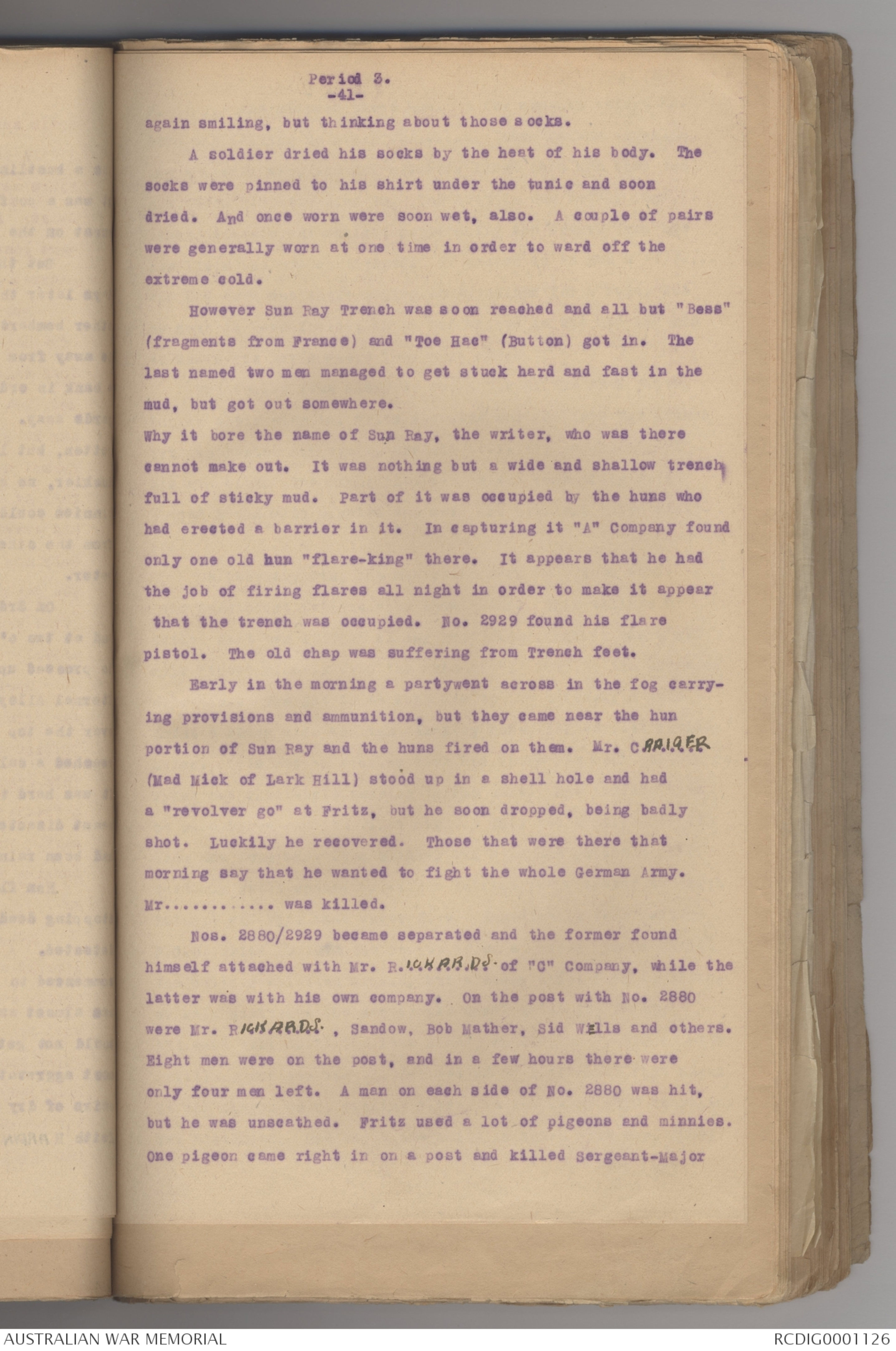
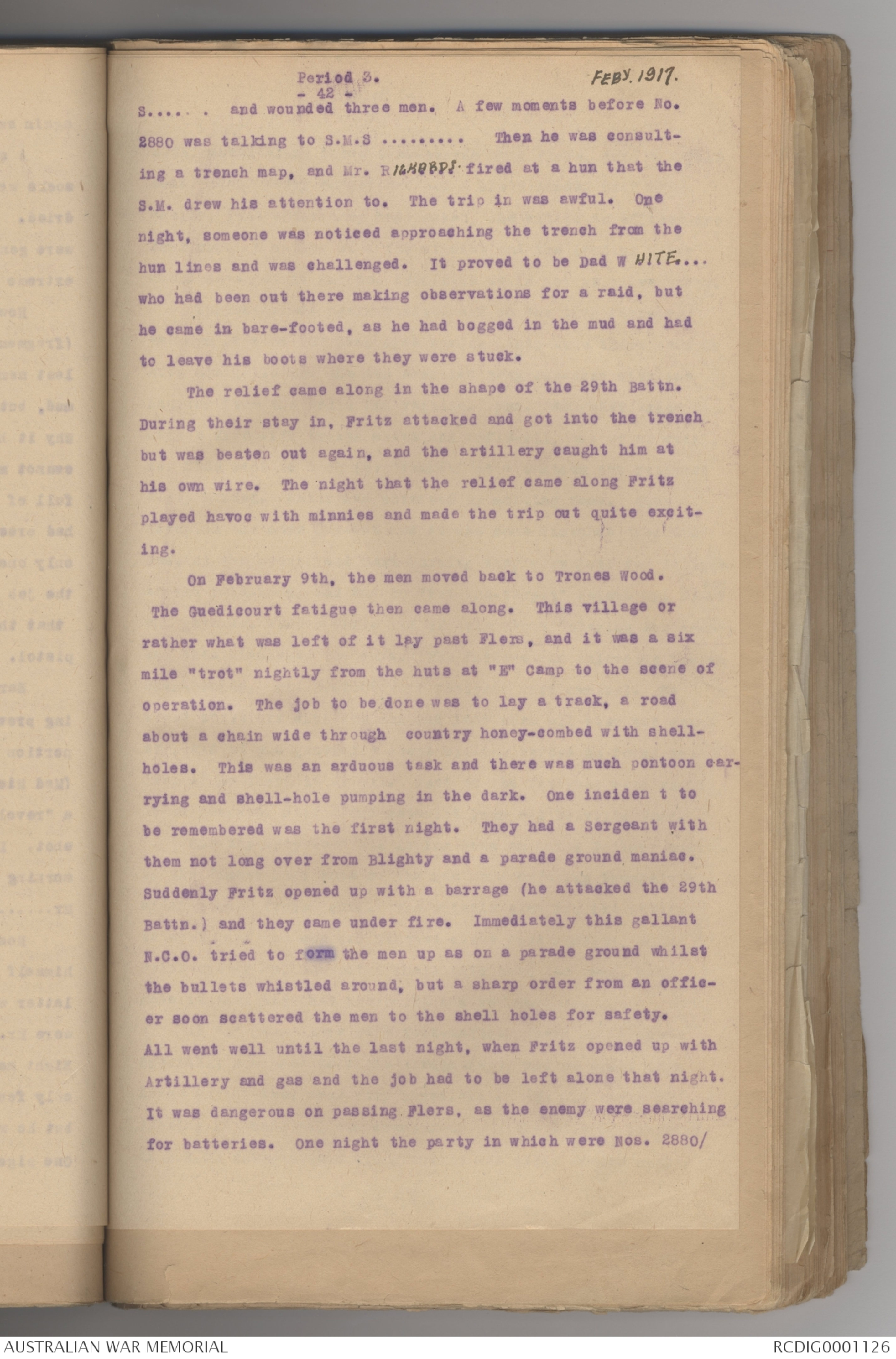
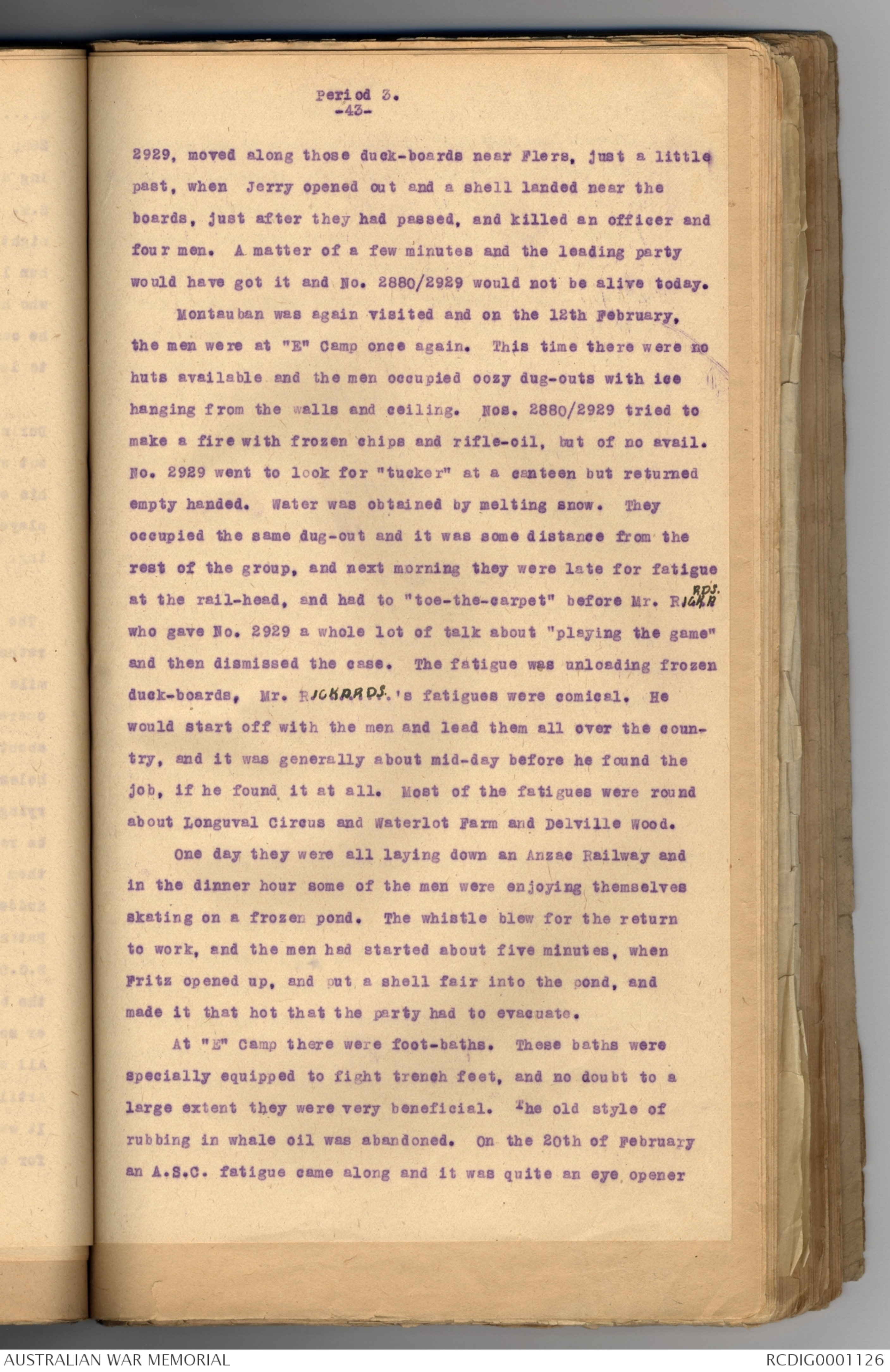
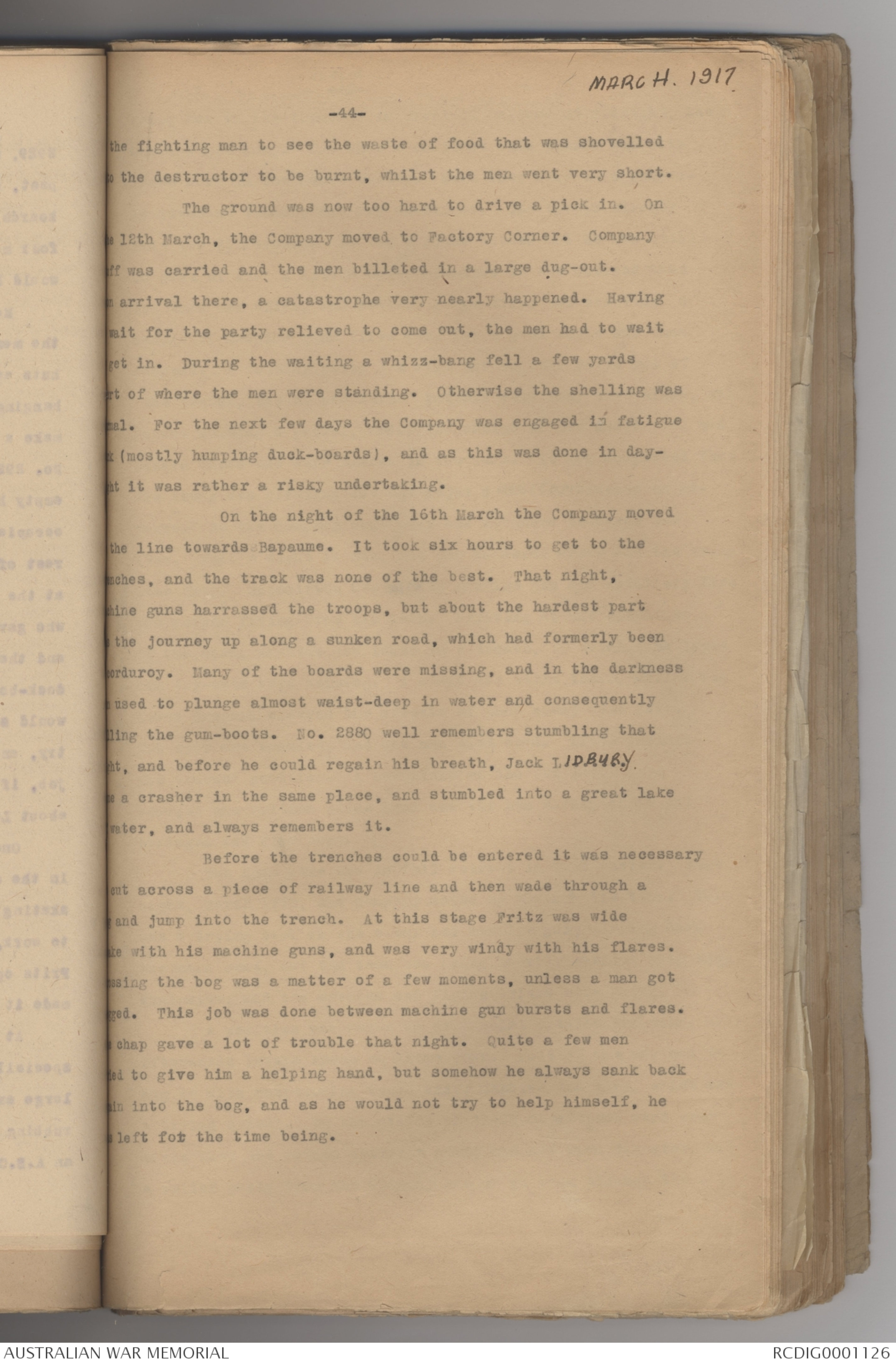
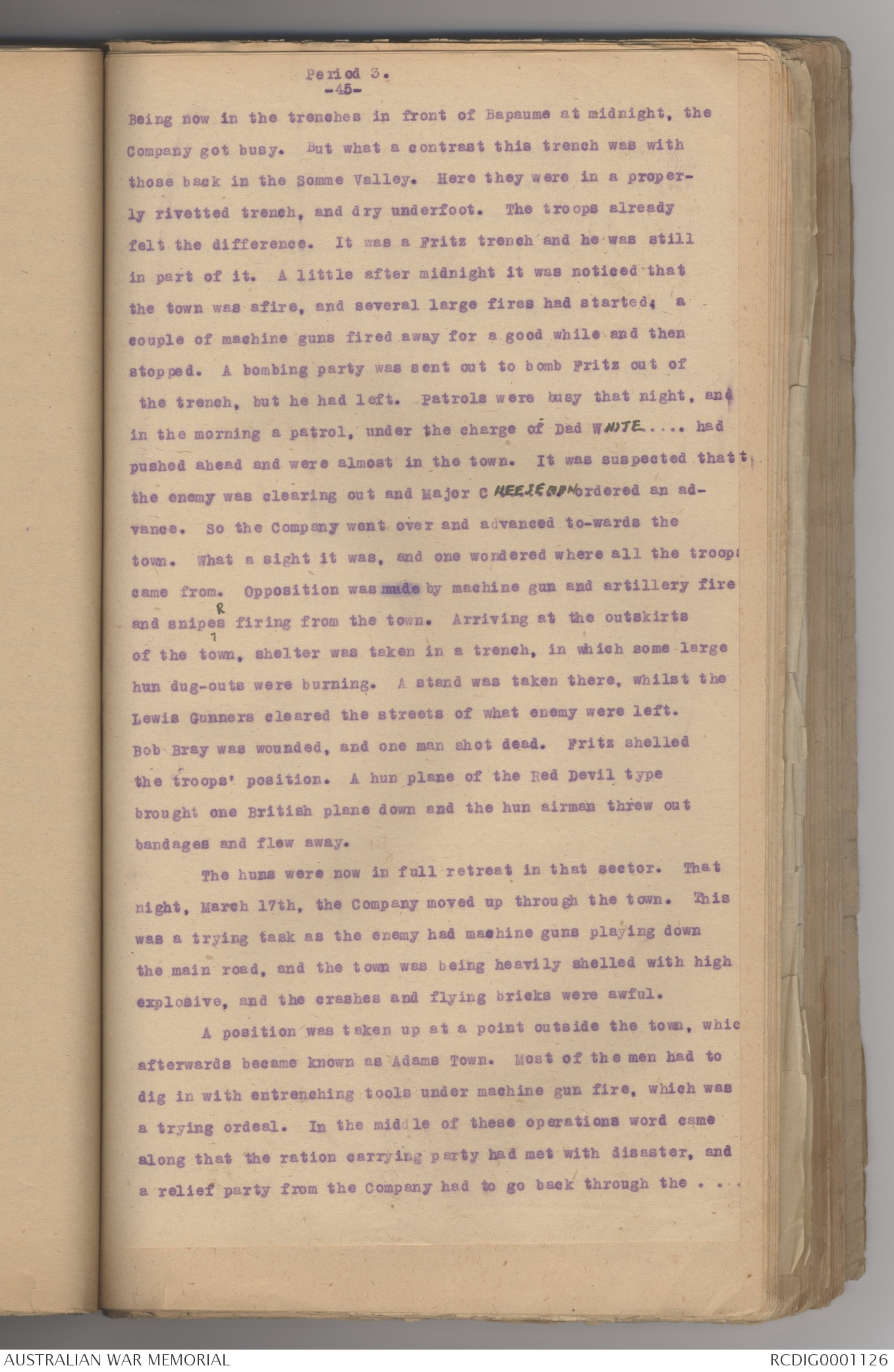
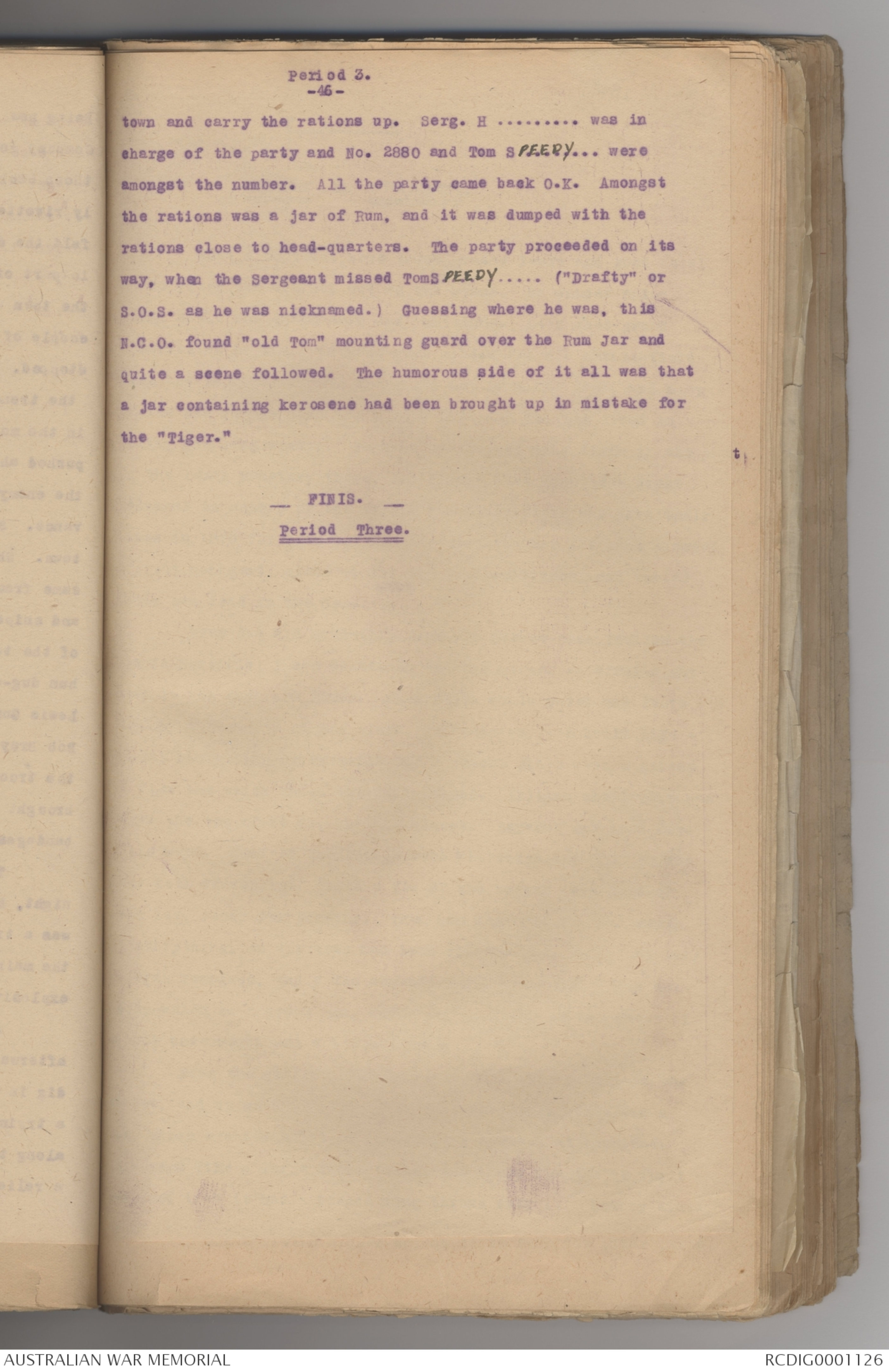
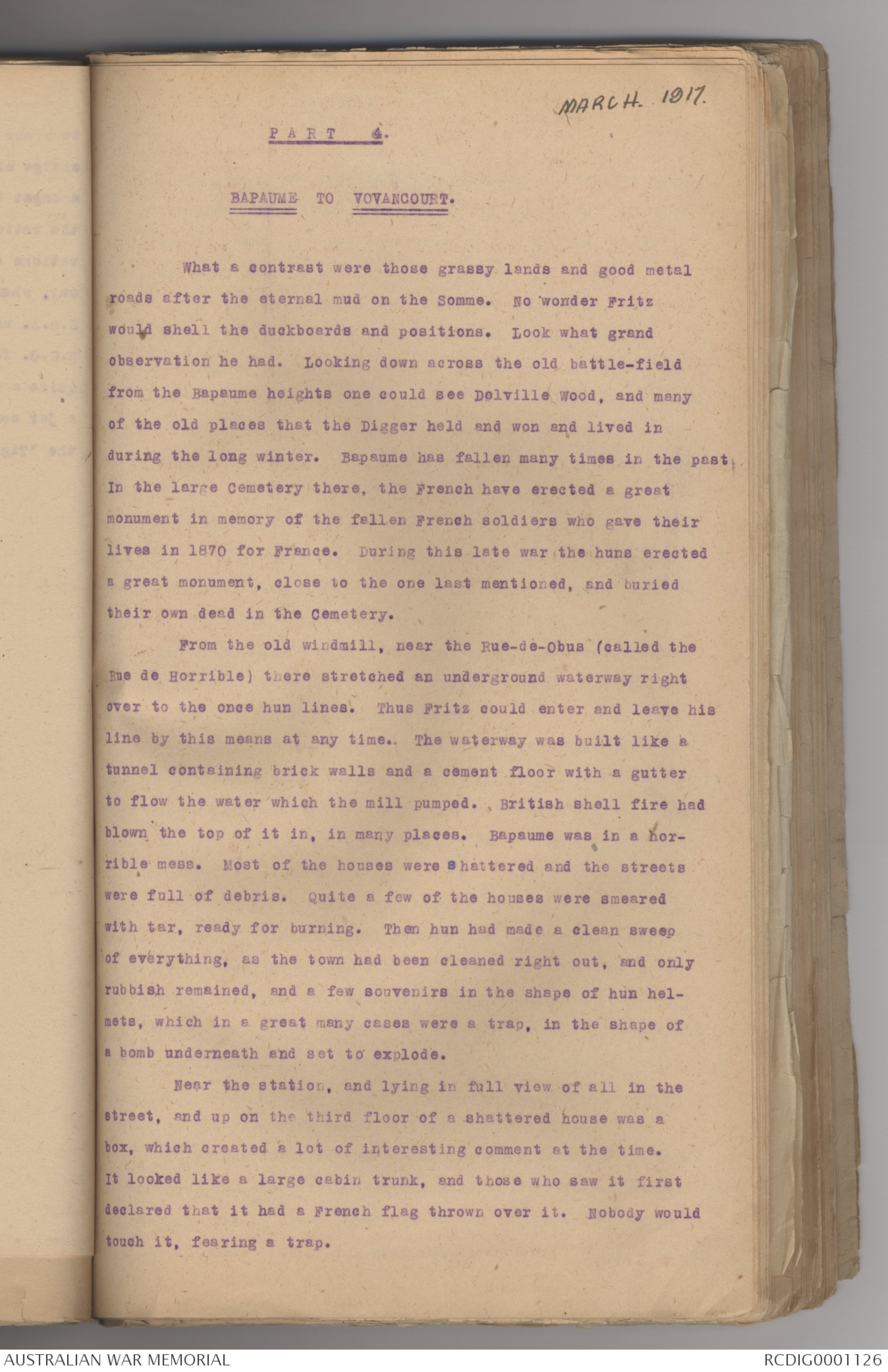
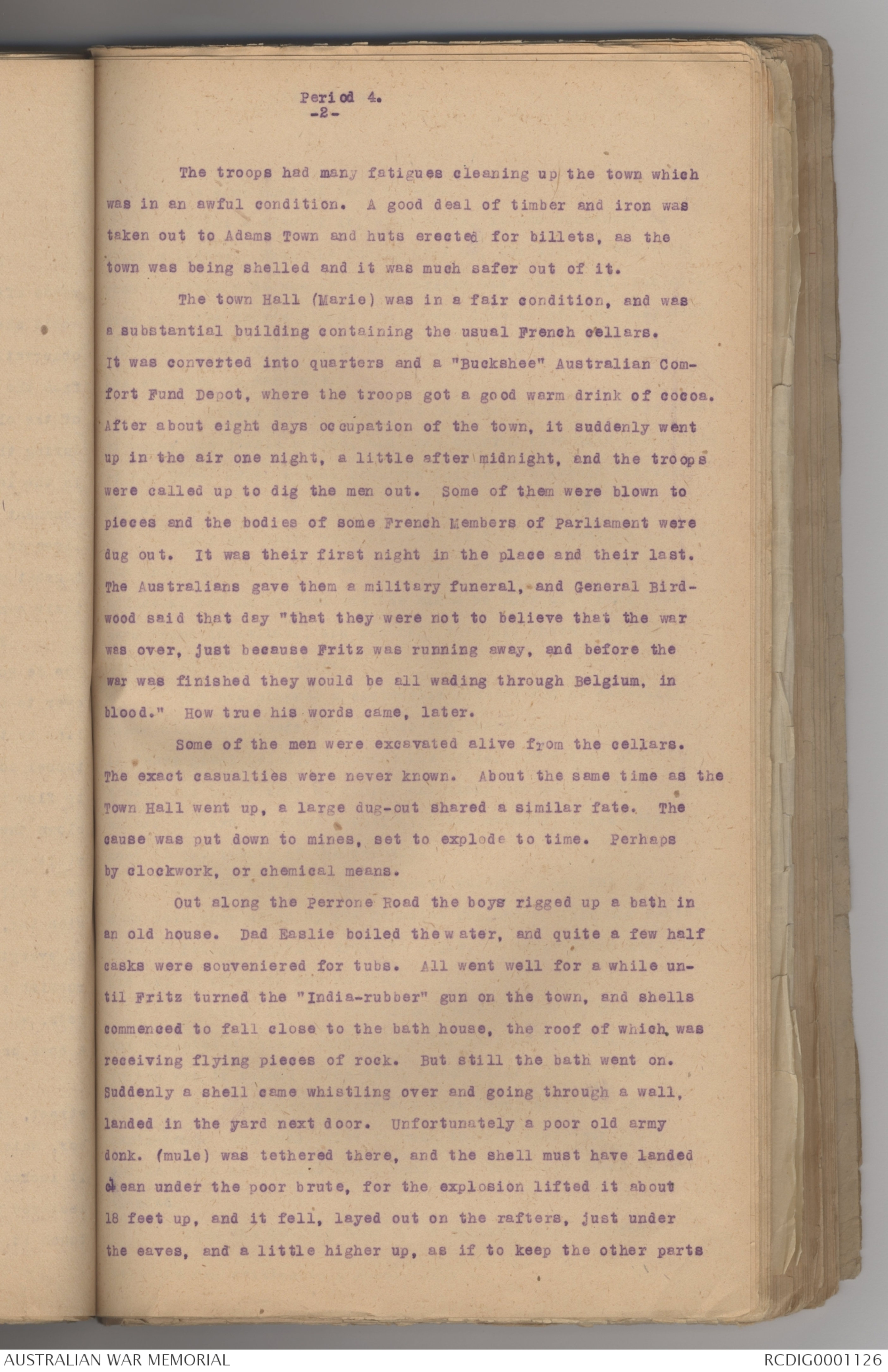
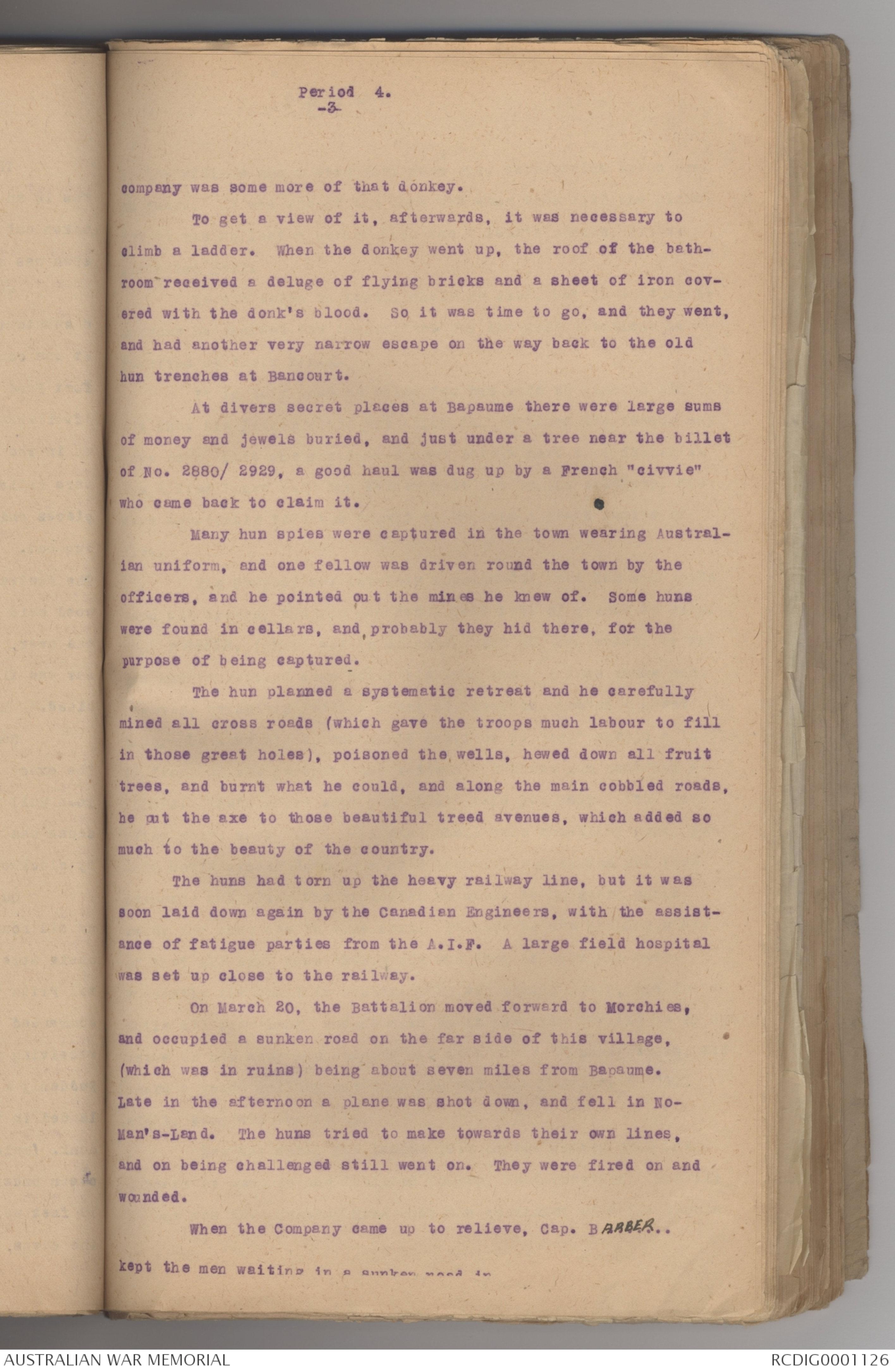
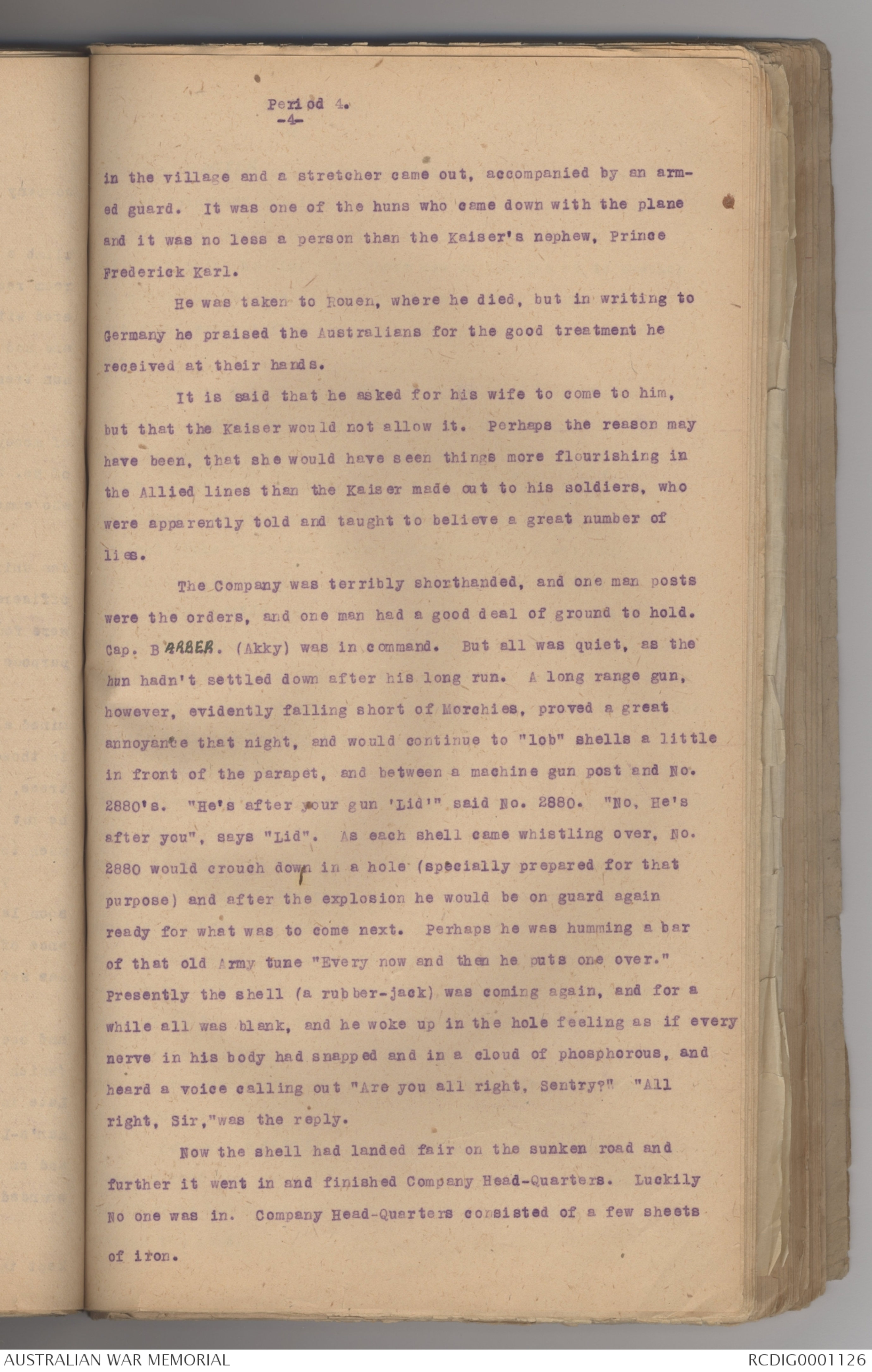
Period 3.
-41-
again smiling, but thinking about those socks.
A soldier dried his socks by the heat of his body. The
socks were pinned to his shirt under the tunic and soon
dried. And once worn were soon wet, also. A couple of pairs
were generally worn at one time in order to ward off the
extreme cold.
However Sun Ray Trench was soon reached and all but "Bess"
(fragments from France) and "Toe Hac" (Button) got in. The
last named two men managed to get stuck hard and fast in the
mud, but got out somewhere.
Why it bore the name of Sun Ray, the writer, who was there
cannot make out. It was nothing but a wide and shallow trench
full of sticky mud. Part of it was occupied by the huns who
had erected a barrier in it. In capturing it "A" Company found
only one old hun "flare-king" there. It appears that he had
the job of firing flares all night in order to make it appear
that the trench was occupied. No. 2929 found his flare
pistol. The old chap was suffering from Trench feet.
Early in the morning a partywent across in the fog carrying
provisions and ammunition, but they came near the hun
portion of Sun Ray and the huns fired on them. Mr. CRAIGER
(Mad Mick of Lark Hill) stood up in a shell hole and had
a "revolver go" at Fritz, but he soon dropped, being badly
shot. Luckily he recovered. Those that were there that
morning say that he wanted to fight the whole German Army.
Mr . . . . . . . . . . . . . was killed.
Nos. 2880/2929 became separated and the former found
himself attached with Mr. RICKARDS of "C" Company, while the
latter was with his own company. On the post with No. 2880
was Mr. RICKARDS, Sandow, Bob Mather, Sid Wells and others.
Eight men were on the post, and in a few hours there were
only four men left. A man on each side of No. 2880 was hit,
but he was unscathed. Fritz used a lot of pigeons and minnies.
One pigeon came right in on a post and killed Sergeant-Major
[*FEBY. 1917.*]
Period 3.
- 42 -
S . . . . . and wounded three men. A few moments before No.
2880 was talking to S.M.S . . . . . . Then he was consulting
a trench map, and Mr. RICKARDS fired at a hun that the
S.M. drew his attention to. The trip in was awful. One
night, someone was noticed approaching the trench from the
hun lines and was challenged. It proved to be Dad WHITE
who had been out there making observations for a raid, but
he came in bare-footed, as he had bogged in the mud and had
to leave his boots where they were stuck.
The relief came along in the shape of the 29th Battn.
During their stay in, Fritz attacked and got into the trench
but was beaten out again, and the artillery caught him at
his own wire. The night that the relief came along Fritz
played havoc with minnies and made the trip out quite exciting.
On February 9th, the men moved back to Trones Wood.
The Guedicourt fatigue then came along. This village or
rather what was left of it lay past Flers, and it was a six
mile "trot" nightly from the huts at "E" Camp to the scene of
operation. The job to be done was to lay a track, a road
about a chain wide through country honey-combed with shell-holes.
This was an arduous task and there was much pontoon carrying
and shell-hole pumping in the dark. One inciden t to
be remembered was the first night. They had a Sergeant with
them not long over from Blighty and a parade ground maniac.
Suddenly Fritz opened up with a barrage (he attacked the 29th
Battn.) and they came under fire. Immediately this gallant
N.C.O. tried to form the men up as on a parade ground whilst
the bullets whistled around, but a sharp order from an officer
soon scattered the men in the shell holes for safety.
All went well until the last night, when Fritz opened up with
Artillery and gas and the job had to be left alone that night.
It was dangerous on passing Flers, as the enemy were searching
for batteries. One night the party in which were Nos. 2880/
Period 3.
-43-
2929, moved along those duck-boards near Flers, just a little
past, when Jerry opened out and a shell landed near the
boards, just after they had passed, and killed an officer and
four men. A matter of a few minutes and the leading party
would have got it and No. 2880/2929 would not be alive today.
Montauban was again visited and on the 12th February,
the men were at "E" Camp once again. This time there were no
huts available and the men occupied cozy dug-outs with ice
hanging from the walls and ceiling. Nos. 2880/2929 tried to
make a fire with frozen chips and rifle-oil, but of no avail.
No. 2929 went to look for "tucker" at a canteen but returned
empty handed. Water was obtained by melting snow. They
occupied the same dug-out and it was some distance from the
rest of the group, and next morning they were late for fatigue
at the rail-head, and had to "toe-the-carpet" before Mr. RICKARDS.
who gave No. 2929 a whole lot of talk about "playing the game"
and then dismissed the case. The fatigue was unloading frozen
duck-boards, Mr, RICKARDS's fatigues were comical. He
would start off with the men and lead them all over the country,
and it was generally about mid-day before he found the
job, if he found it at all. Most of the fatigues were round
about Longuval Circus and Waterlot Farm and Delville Wood.
One day they were all laying down an Anzac Railway and
in the dinner hour some of the men were enjoying themselves
skating on a frozen pond. The whistle blew for the return
to work, and the men had started about five minutes, when
Fritz opened up, and put a shell fair into the pond, and
made it that hot that the party had to evacuate.
At "E" Camp there were foot-baths. These baths were
specially equipped to fight trench feet, and no doubt to a
large extent they were very beneficial. The old style of
rubbing in whale oil was abandoned. On the 20th of February
an A.S.C. fatigue came along and it was quite an eye opener
[*MARCH. 1917*]
-44- AWAITING PAGE RESCAN
[[?]] the fighting man to see the waste of food that was shovelled
[[into?]] the destructor to be burnt, whilst the men went very short.
The ground was now too hard to drive a pick in. On
the 12th March, the Company moved to Factory Corner. Company
[[ff?]] was carried and the men billeted in a large dug-out.
On arrival there, a catastrophe very nearly happened. Having
[[to?]] wait for the party relieved to come out, the men had to wait
[[to?]] get in. During the waiting a whizz-bang fell a few yards
[[short?]] of where the men were standing. Otherwise the shelling was
[[normal?]]. For the next few days the Company was engaged in fatigue
[[work?]] (mostly humping duck-boards), as this was done in daylight
it was rather a risky undertaking.
On the night of the 16th March the Company moved
[[up?]] the line towards Bapaume. It took six hours to get to the
[[trenches?]], and the track was none of the best. That night,
[[machine?]] guns harassed the troops, but about the hardest part
[was?]] the journey up along a sunken road, which had formerly been
corduroy. Many of the boards were missing, and in the darkness
[[n?]] used to plunge almost waist-deep in water and consequently
[[filling?]] the gum-boots. No.2880 well remembers stumbling that
[[night?]], and before he could regain his breath, Jack LIDBURY
[[me?]] a crasher in the same place, and stumbled into a great lake
[[of?]] water, and always remembers it.
Before the trenches could be entered it was necessary
[[?]] cut across a piece of railway line and then wade through a
[[?]] and jump into the trench. At this stage Fritz was wide
[[ake?]] with his machine guns, and was very windy with his flares.
[[ossing?]] the bog was a matter of a few moments, unless a man
[[gged?]]. This job was done between machine gun bursts and flares.
[[e?]] chap gave a lot of trouble that night. Quite a few men
[[tried?]] to give him a helping hand, but somehow he always sank back
[[ain?]] into the bog, and as he would not try to help himself, he
[[was?]] left for the time being.
Period 3.
-45-
Being now in the trenches in front of Bapaume at midnight, the
Company got busy. But what a contrast this trench was with
those back in the Somme Valley. Here they were in a properly
rivetted trench, and dry underfoot. The troops had already
felt the difference. It was a Fritz trench and he was still
in part of it. A little after midnight it was noticed that
the town was afire, and several large fires had started; a
couple of machine guns fired away for a good while and then
stopped. A bombing party was sent out to bomb Fritz out of
the trench, but he had left. Patrols were very busy that night, and
in the morning a patrol, under the charge of Dad WHITE had
pushed ahead and were almost in the town. It was suspected thatt
the enemy was clearing out and Major CHEESEMAN ordered an advance.
So the Company went over and advanced to-wards the
town. What a sight that was, and one wondered where all the troops
came from. Opposition was made by machine gun and artillery fire
and snipe^Rs firing from the town. Arriving at the outskirts
of the town, shelter was taken in a trench, in which some large
hun dug-outs were burning. A stand was taken there, whilst the
Lewis Gunners cleared the streets of what enemy were left.
Bob Bray was wounded, and one man shot dead. Fritz shelled
the troops' position. A hun plane of the Red Devil type
brought one British plane down and the hun airman threw out
bandages and flew away.
The huns were now in full retreat in that sector. That
night, March 17th, the Company moved up through the town. This
was a trying task time as the enemy had machine guns playing down
the main road, and the town was being heavily shelled with high
explosive, and the crashes and flying bricks were awful.
A position was taken up at a point outside the town, which
afterwards became known as Adams Town. Most of the men had to
dig in with entrenching tools under machine gun fire, which was
a trying ordeal. In the middle of these operations word came
along that the rations carrying party had met with disaster, and
a relief party from the Company had to go back through the . . .
Period 3.
-46-
town and carry the rations up. Serg. H . . . . . . . . . was in
charge of this party and No. 2880 and Tom SPEEDY were
amongst the number. All the party came back O.K. Amongst
the rations was a jar of Rum, and it was dumped with the
rations close to head-quarters. The party proceeded on its
way, when the Sergeant missed Tom SPEEDY ("Drafty" or
S.O.S. as he was nicknamed.) Guessing where he was, this
N.C.O. found "old Tom" mounting guard over the Rum Jar and
quite a scene followed. The humorous side of it all was that
a jar containing kerosene had been brought up in mistake for
the "Tiger,"
_ FINIS. _
Period Three.
[*MARCH. 1917.*]
PART 4.
BAPAUME TO VOVACOURT.
What a contrast were those grassy lands and good metal
roads after the eternal mud on the Somme. No wonder Fritz
would shell the duckboards and positions. Look what grand
observations he had. Looking down across the old battle-field
from the Bapaume heights one could see Delville Wood, and many
of the old places that the Digger held and won and lived in
during the long winter. Bapaume has fallen many times in the past.
In the large Cemetery there, the French have erected a great
monument in memory of the fallen French soldiers who gave their
lives in 1870 for France. During this late war the huns erected
a great monument, close to the one last mentioned, and buried
their own dead in the Cemetery.
From the old windmill, near the Rue-de-Obus (called the
Rue de Horrible) there stretched an underground waterway right
over to the once hun lines. Thus Fritz could enter and leave his
line by this means at any time. The waterway was built like a
tunnel containing brick walls and a cement floor with a gutter
to flow the water which the mill pumped. British shell fire had
blown the top of it in, in many places. Bapaume was in a horrible
mess. Most of the houses were shattered and the streets
were full of debris. Quite a few of the houses were smeared
with tar, ready for burning. Then hun made a clean sweep
of everything, as the town had been cleaned right out, and only
rubbish remained, and a few souvenirs in the shape of hun helmets,
which in a great many cases were a trap, in the shape of
a bomb underneath and set to explode.
Near the station, and lying in full view of all in the
street, and up on the third floor of a shattered house was a
box, which created a lot of interesting comment at the time.
It looked like a large cabin trunk, and those who saw it first
declared that it had a French flag thrown over it, Nobody would
touch it, fearing a trap.
Period 4.
-2-
The troops had many fatigues cleaning up the town which
was in an awful condition. A good deal of timber and iron was
taken out to Adams Town and huts erected for billets, as the
town was being shelled and it was much safer out of it.
The town Hall (Marie) was in a fair condition, and was
a substantial building containing the usual French cellars.
It was converted into quarters and a "Buckshee" Australian Comfort
Fund Depot, where the troops got a good warm cup of cocoa.
After about eight days occupation of the town, it suddenly went
up in the air one night, a little after midnight, and the troops
were called up to dig men out. Some of them were blown to
pieces and the bodies of some French Members of Parliament were
dug out. It was their first night in the place and their last.
The Australians gave them a military funeral, and General Birdwood
said that day "that they were not to believe that the war
was over, just because Fritz was running away, and before the
war was finished they would be all wading through Belgium, in
blood." How true his words came, later.
Some of the men were evacuated alive from the cellars.
The exact casualties were never known. About the same time as the
Town Hall went up, a large dug-out shared a similar fate. The
cause was put down to mines, set to explode to time. Perhaps
by clockwork, or chemical means.
Out along the Perrone Road the boys rigged up a bath in
an old house. Dad Easlie boiled the water, and quite a few half
casks were souveniered for tubs. All went well for a while until
Fritz turned the "Indian-rubber" gun on the town, and shells
commenced to fall close to the bath house, the roof of which was
receiving flying pieces of rock. But still the bath went on.
Suddenly a shell came whistling over and going through a wall,
landed in the yard next door. Unfortunately a poor old army
donk. (mule) was tethered there, and the shell must have landed
clean under the poor brute, for the explosion lifted it about
18 feet up, and it fell, layed out on the rafters, just under
the eaves, and a little higher up, as if to keep the other parts
Period 4.
-3-
company was some more of that donkey.
To get a view of it, afterwards, it was necessary to
climb a ladder. When the donkey went up, the roof of the bathroom
received a deluge of flying bricks and a sheet of iron covered
with the donk's blood. So it was time to go, and they went,
and had another very narrow escape on the way back to the old
hun trenches at Bancourt.
At divers secret places at Bapaume there were large sums
of money and jewels buried, and just under a tree near the billet
of No. 2880/2929, a good haul was dug up by a French "civvie"
who came back to claim it.
Many hun spies were captured in the town wearing Australian
uniform, and one fellow was driven round the town by the
officers, and he pointed out the mines he knew of. Some huns
were found in cellars, and, probably they hid there, for the
purpose of being captured.
The hun planned a systematic retreat and he carefully
mined all cross roads (which gave the troops much labour to fill
in those great holes), poisoned the wells, hewed down all fruit
trees, and burnt what he could, and along the main cobbled roads,
he put the axe to those beautiful treed avenues, which added so
much to the beauty of the country.
The huns had torn up the heavy railway line, but it was
soon laid down again by the Canadian Engineers, with the assistance
of fatigue parties from the A.I.F. A large field hospital
was set up close to the railway.
On March 20, the Battalion moved forward to Morchies,
and occupied a sunken road on the far side of this village,
(which was in ruins) being about seven miles from Bapaume.
Late in the afternoon a plane was shot down, and fell in No-Man's-Land.
The huns tried to make towards their own lines,
and on being challenged still went on. They were fired on and
wounded.
When the Company came up to relieve, Cap. BARBER
kept the men waiting in a sunken road in
Period 4.
-4-
in the village and a stretcher came out, accompanied by an armed
guard. It was one of the huns who came down with the plane
and it was no less a person than the Kaiser's nephew, Prince
Frederick Karl.
He was taken to Rouen, where he died, but in writing to
Germany he praised the Australians for the good treatment he
received at their hands.
It is said that he asked for his wife to come to him,
but that the Kaiser would not allow it. Perhaps the reason may
have been, that she would have seen things more flourishing in
the Allied lines than the Kaiser made out to his soldiers, who
were apparently told and taught to believe a great number of
lies.
The Company was terribly shorthanded, and one man posts
were the orders, and one man had a great deal of ground to hold.
Cap. BARBER. (Akky) was in command. But all was quiet, as the
hun hadn't settled down after his long run. A long range gun,
however, evidently falling short of Morchies, proved a great
annoyance that night, and would continue to "lob" shells a little
in front of the parapet, and between a machine gun post and No.
2880's. "He's after your gun 'Lid'" said No. 2880. "No, He's
after you", says "Lid". As each shell came whistling over, No.
2880 would crouch down in a hole (specially prepared for that
purpose) and after the explosion he would be on guard again
ready for what was to come next. Perhaps he was humming a bar
of that old Army tune "Every now and then he puts one over."
Presently the shell (a rubber-jack) was coming again, and for a
while all was blank, and he woke up in the hole feeling as if every
nerve in his body had snapped and in a cloud of phosphorous, and
heard a voice calling out "Are you all right, Sentry?" "All
right, Sir,"was the reply.
Now the shell had landed fair on the sunken road and
further it went in and finished Company Head-Quarters. Luckily
No one was in. Company Head-Quarters consisted of a few sheets
of iron.
 Sam scott
Sam scottThis transcription item is now locked to you for editing. To release the lock either Save your changes or Cancel.
This lock will be automatically released after 60 minutes of inactivity.